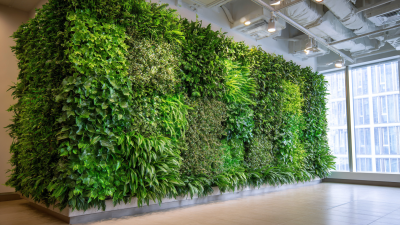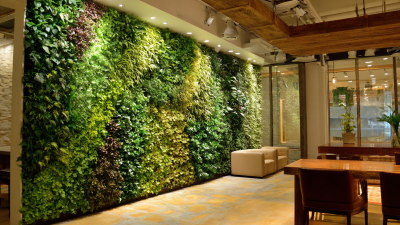As the demand for sustainable and aesthetically pleasing urban environments continues to grow, traditional Grass Wall solutions have come under scrutiny for their environmental impact and maintenance challenges. According to a report by the Green Building Council, over 80% of urban landscapes contribute to heat islands, emphasizing the need for innovative alternatives that enhance biodiversity while reducing energy consumption. Research indicates that living walls, often integrated with various plant species, not only improve air quality but also provide substantial insulation, potentially lowering heating and cooling costs by up to 30%. This shift towards modern alternatives highlights a pivotal transition in landscape architecture, where innovative technologies and eco-friendly practices redefine our approach to urban green spaces. Exploring effective substitutes to conventional Grass Wall methods can offer sustainable benefits and inspire architects and city planners toward a more resilient future.

Vertical gardening offers an innovative solution for maximizing space within indoor environments, catering to the need for sustainable and aesthetically pleasing greenery in our lives. According to a report by the National Gardening Association, around 35% of U.S. households participate in indoor gardening, and vertical gardens can significantly increase the appeal and functionality of these spaces. Techniques such as wall-mounted planters, trellises, and modular systems not only save floor space but also enhance air quality and provide natural insulation.
Research published in the Journal of Indoor Environment Sciences suggests that vertical gardens can reduce indoor temperature by up to 10%, making them an eco-friendly alternative to traditional heating or cooling methods. The use of hydroponic or aeroponic systems in vertical gardening can further optimize plant growth, allowing for year-round cultivation of herbs and vegetables. The integration of these techniques not only promotes biodiversity in urban settings but also encourages a healthier lifestyle by making fresh produce more accessible, driving a trend that aligns with the growing demand for local and organic food sources.
| Technique | Description | Benefits | Maintenance Level |
|---|---|---|---|
| Vertical Planters | Utilizes stackable containers for planting. | Space-saving, customizable designs. | Low |
| Living Walls | Framework containing soil and plants mounted on walls. | Improves air quality, aesthetic appeal. | Medium |
| Hydroponic Systems | Soil-less growing systems utilizing nutrient-rich water. | Higher growth rates, less water usage. | High |
| Moss Walls | Walls covered with preserved moss. | Low maintenance, natural sound absorption. | Very Low |
| Trellis Gardens | Climbing plants grown on a support structure. | Visual interest, efficient use of vertical space. | Medium |
In recent years, the need for sustainable and eco-friendly building materials has gained significant attention. Traditional grass walls, while aesthetic, can be replaced with innovative alternatives that boast both environmental benefits and durability. One notable option is the use of natural fibers, such as jute and hemp. These materials are renewable and provide excellent insulation, making them a perfect substitute for conventional grass wall solutions.
Tips: When considering material for your grass wall alternatives, look for local suppliers of natural fibers to reduce your carbon footprint. Additionally, opting for materials that utilize recycled waste substrates not only supports sustainability but also often leads to cost savings in your building projects.
Moreover, innovations in cellulose extraction and the creation of composites from lignocellulosic biomass further push the boundaries of eco-friendly construction. These methods not only enhance the strength and durability of building materials but also ensure that they are low-impact and environmentally safe. Integrating these innovative solutions into home design not only promotes sustainability but also contributes to a more resilient and eco-conscious living space.
Tips: Explore recent advancements in biodegradable materials and assess their suitability for your project. Consider incorporating a mix of natural fibers and composites to achieve the desired aesthetic while maximizing sustainability.
Artificial greenery has emerged as a game-changer in modern design, providing a low-maintenance alternative to traditional grass wall solutions. With the benefits of durability and versatility, incorporating faux plants allows for vibrant, lush visuals without the hassle of upkeep. Whether you're designing an indoor office space or an outdoor garden area, artificial greenery can enhance the aesthetic appeal while eliminating the challenges associated with real plants.
When selecting artificial plants, opt for high-quality materials that resemble natural foliage closely. This attention to detail can elevate your design, ensuring that it looks convincing and appealing. Additionally, consider using a mix of textures and colors to create depth and visual interest in your walls.
To maintain the pristine condition of your artificial greenery, regular dusting is essential. A soft cloth or a gentle vacuum attachment can keep your plants looking fresh. Another tip is to place the greenery in well-lit areas to enhance their appearance, creating an inviting and lively atmosphere. Incorporating artificial greenery not only allows for unique designs but also provides an eco-friendly solution that requires minimal maintenance.

In the world of landscaping, the creative use of climbers and vines is revolutionizing how we approach natural aesthetics. Various reports have shown that vertical gardening, particularly utilizing climbing plants, can enhance urban environments by improving air quality and reducing noise levels. According to a study by the Green Roofs for Healthy Cities, green walls can reduce ambient temperatures by up to 30%, creating not just a visually appealing space but also a more comfortable environment. This makes vine-covered structures an increasingly appealing option for both residential and commercial properties.
Additionally, climbing plants can offer flexibility and sustainability, thriving in a range of environments while requiring minimal maintenance once established. A report by the American Society of Landscape Architects indicates that using perennial vines significantly reduces irrigation needs compared to traditional lawn solutions, making them an eco-friendly alternative. Species such as jasmine, clematis, and wisteria not only provide lush greenery but also attract pollinators, contributing to local biodiversity.
As cities continue to embrace greener solutions, the role of climbers and vines in enhancing both beauty and functionality cannot be overstated.
The rise of green wall technology has transformed urban landscapes, combining ecological benefits with innovative design. According to a recent report by the World Green Building Council, green walls can reduce indoor air temperatures by up to 50% and decrease energy usage for heating and cooling by approximately 30%. Smart technologies now enhance these benefits, making green walls more efficient and manageable.
For instance, systems integrated with IoT sensors monitor moisture levels and nutrient supply, ensuring optimal plant health while reducing water consumption by as much as 40%, as detailed in a study published by the Journal of Urban Ecology. Additionally, automated irrigation systems enable precise watering schedules, promoting sustainable practices in urban architecture.
By implementing these technologies, urban planners and architects can create vibrant, self-sustaining green spaces that not only enhance the aesthetic appeal but also contribute significantly to energy conservation and improved air quality in densely populated areas.













